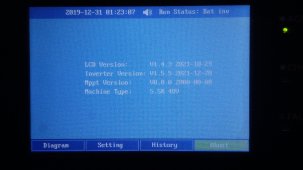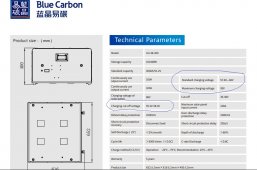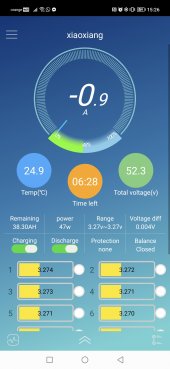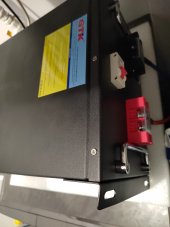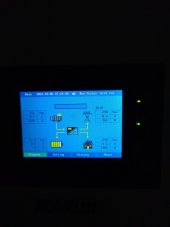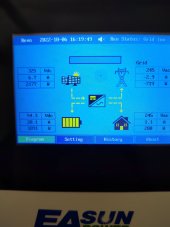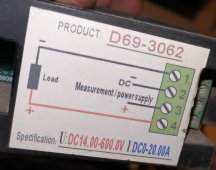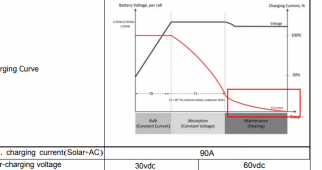Thanks for explaining that part.
Funny to see that your Revo II isn't reporting the -1A.
Obviously you are loosing a few hundred watts looking at the total numbers of solar, AC, and actual consumption

I don't have grid, but when my batteries are fully charged, the solar panels produce what we consume.
And it drains the battery with atleast 1A.
It's a larger setup, and I leaned to live with the energy consumption of the Revo, counted me lucky I didn't have to worry about the 3.5 kWh drain of the grid each day.
If I understand you correctly, your battery voltage needs to drop to 52v (roughly 50% SOC) before it starts topping up again.
And you like this to start at higher SOC, so you keep maximal battery capacity at all times.
probably most cheap and simple solution:
double your battery capacity.
not what you like to hear, but the Revo will eat.
im not sure if it still will eat the 160w if the grid is not available.
it will keep using the 1A from the battery, have +/- 75W own consumption for being turned on as inverter,
And eat the first 100 watt from your solar panels before the MPPT starts working.
We are talking about 2kwh here for a backup installation..
Lifepo4 likes 85-90% as maximum charge to live the longest.
It likes slow cycles instead of static charge.
It doesn't like too deep discharge, keep it above 10-15%
And where all the numbers are optimistic, I like to calculate with 85% efficiency for using the stored enery from the cells.
most optimal 70% of your 5 kWh battery, (85 top, 15 bottom) x 85% , usable about 3 kWh.
Stretching it perhaps 3.5
If you don't care about damage and drain the last drop, 3.8 kWh?
Now there is a huge difference between being able to use 2 kWh (at a moment the battery is about 50% SOC/ 52v) and 3 kWh when it is at 85% (53.5v)
For led lights, 2 or 3 kWh is a lot.
For normal living, it's used up quite fast.
Refrigerator, all the standby equipment and chargers, TV/ laptop/ computer. Heating up some water for coffee or so...
Our 50 kWh is out of need as there is no backup.
But we easy consume 15 kWh a night (about 15 hours a day running of (partly) battery)
Sure, Thailand is hot, so the refrigerator needs to work harder, we don't have utility, using water is using electricity for the pumps.
Still...
2 -3 kWh is in my opinion a really small buffer.
Trying to optimise it will end up costing more then just have enough.
Thrust me, I've been there.
According to match 18 x 325w panels should be enough...
It wasn't.
Then added 9 more...
Eventually + 16 x 345w, now it's enough.
Original 16 x 200Ah deep cycle lead acid.
EASUN hybrid (not a Sorotec OEM but Voltronic) charged it with 78v...
That took a few weeks before all the batteries died.
Lead acid is strong ??
During that time I already discovered that it was crap, not enough usable energy stored.
EASUN demanded the 3 units back for resell, as is, defective and all...
I shipped to their agent in Thailand, and received 60% refund from Alibaba. (The duties and tax lost)
The €4500 loss on lead acid.....
Still waiting for them to compensate that!!!
I started with 3 x 152ah Eve lifepo4 after this, added 2 X 280Ah as 456Ah wasn't enough...
Then there was a fire...
Now 3 x 260Ah BYD
And 1 set of recovered 280Ah Eve cells
Yes, + 1000Ah is a lot.
50 kWh.
But when that is your only power source and there are days with only rain, you need to be able to do 3 days "without" sunlight.
I used to have my GPU mining setup to consume the energy we don't need, 500-1000 watt, depending on the weather.
That's history now due Ethereum changes.
The numbers all look nice on paper.
In real life you need to double it as there are "leaks" all over the place.
I'm actually surprised that you are worried about the 50 watt drain from the battery, and not the 160W drain from AC, with the current energy prices!!
To stop the drain of the battery, simply select "battery less" operation, and if the grid does stop, turn it back on again.
Note: you need to choose "lead acid" in the options, otherwise it won't start using the battery.
After this you can change it to lithium
Note 2: this is strangely enough S15, not S16.
But conservative enough to not drain below 2.5v
Or just increase the battery capacity.
Did you already test?
How long you can "live" of the backup power?
Doing your normal things as you normally would?
How long to you want to be able to "survive" when the grid has a probelm?
My experience might be different then yours, I thought I was conservative with my estimations, but it turned out to be way off.
Most other people I speak have this "wake up call" that it doesn't perform as they expected.
More panels and more batteries are usually the cheapest fix.
Be happy you don't have to deal with lead acid

That efficiency getting energy into it (you lose 20%) ,the amount you can take out (40%) , and the efficiency of that... (Lose again 15%)
Lifepo4 is near perfect, you can use 70% without probelms.
If you don't care about lifetime even close to 100%
And +95% instead of the 85% of lead acid ??
So much better.
Of the 100Ah you can use 65-75%...
At 85% efficient conversion to AC roughly 3 kWh.
That's not bad, but that is "all".
If you need more...
Increase the capacity.



